Female
Pattern Baldness
Female pattern
baldness, in which the midline parting of the hair appears
broadened, is less common. It is believed to result from a
decrease in estrogen, a hormone that normally counteracts the
balding effect of testosterone, which normally occurs in women's
blood. Female pattern baldness is being classified on the Ludwig
scale I-III.
Hair Loss In Women
(Ludwig Classification)
Type I. Early thinning that can be easily camouflaged with proper
grooming. Type I patients have too little hair loss to
consider surgical hair restoration. |
 |
| |
|
Type II. Significant widening of the midline part and noticeably
decreased volume. Hair transplantation may be indicated if
the donor area in the back and sides of the scalp is
stable. |
 |
| |
|
Type III. A thin, see-through look on the top of the scalp. This is
often associated with generalized thinning. |
 |
Hair loss can be
temporary or long lasting. Temporary hair loss can be easy to
fix when its cause is identified and dealt with or difficult
when it is not immediately clear what the cause is. Hair loss
that could have been merely temporary may become long lasting as
a result of an incorrect diagnosis. The potential for such
misdiagnoses is perhaps the most frustrating aspect of hair loss
for women. The information in this section will help you
identify the cause of your hair loss and ideally lead you and
your doctors to the right treatments for your particular kind of
hair loss sooner rather than later.
Alopecia is the medical term for excessive or abnormal hair
loss. There are different kinds of alopecia. What all hair loss
has in common, whether it's in men or women, is that it is
always a symptom of something else that's gone wrong in your
body. Your hair will remain on your head where it belongs if
hormone imbalance, disease, or some other condition is not
occurring. That condition may be as simple as having a gene that
makes you susceptible to male or female pattern baldness or one
of the forms of alopecia areata. or it may be as complex as a
whole host of diseases. Fortunately, hair loss may also be a
symptom of a short-term event such as stress, pregnancy, and the
taking of certain medications. In these situations, hair will
grow back when the event has passed. Substances (including
hormones), medications, and diseases can cause a change in the
hair growth and shedding phases and in their durations. When
this happens, synchronous growth and shedding occur. Once the
cause is dealt with, hairs go back to their random pattern of
growth and shedding, and your hair loss problem stops.
The following are the most common causes of women’s hair loss:
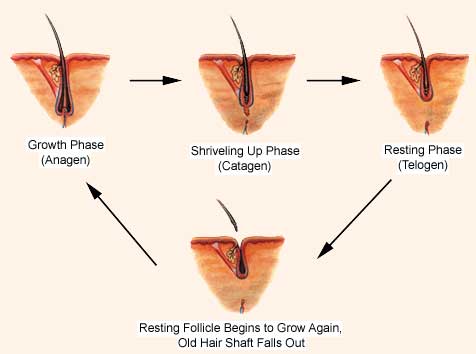
Andogenetic
Alopecia

The
majority of women with androgenic alopecia have diffuse thinning
on all areas of the scalp. Men on the other hand, rarely have
diffuse thinning but instead have more distinct patterns of
baldness. Some women may have a combination of two pattern
types. Androgenic alopecia in women is due to the action of
androgens, male hormones that are typically present in only
small amounts. Androgenic alopecia can be caused by a variety of
factors tied to the actions of hormones, including, ovarian
cysts, the taking of high androgen index birth control pills,
pregnancy, and menopause. Just like in men the hormone DHT
appears to be at least partially to blame for the
miniaturization of hair follicles in women suffering with female
pattern baldness. Heredity plays a major factor in the disease. 
Telogen
Effluvium
When your
body goes through something traumatic like child birth,
malnutrition, a severe infection, major surgery, or extreme
stress, many of the 90 percent or so of the hair in the anagen
(growing) phase or catagen (resting) phase can shift all at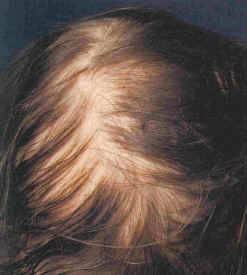 once
into the shedding (telogen) phase. About 6 weeks to three month
after the stressful event is usually when the phenomenon called telogen effluvium can begin. It is possible to lose handful of
hair at time when in full-blown telogen effluvium. For most who
suffer with TE complete remission is probable as long as
severely stressful events can be avoided. For some women
however, telogen effluvium is a mysterious chronic disorder and
can persist for months or even years without any true
understanding of any triggering factors or stressors. once
into the shedding (telogen) phase. About 6 weeks to three month
after the stressful event is usually when the phenomenon called telogen effluvium can begin. It is possible to lose handful of
hair at time when in full-blown telogen effluvium. For most who
suffer with TE complete remission is probable as long as
severely stressful events can be avoided. For some women
however, telogen effluvium is a mysterious chronic disorder and
can persist for months or even years without any true
understanding of any triggering factors or stressors.
Anagen Effluvium
Anagen
effluvium occurs after any insult to the hair follicle that
impairs its mitotic or metabolic activity. This hair loss is
commonly associated with chemotherapy. Since chemotherapy
targets your body’s rapidly dividing cancer cells, your body’s
other rapidly dividing cells such as hair follicles in the
growing (anagen) phase, are also greatly affected. Soon after
chemotherapy begins approximately 90 percent or more of the
hairs can fall out while still in the anagen phase.
The
characteristic finding in anagen effluvium is the tapered
fracture of the hair shafts. The hair shaft narrows as a result
of damage to the matrix. Eventually, the shaft fractures at the
site of narrowing and causes the loss of hair.
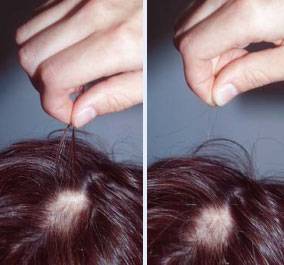 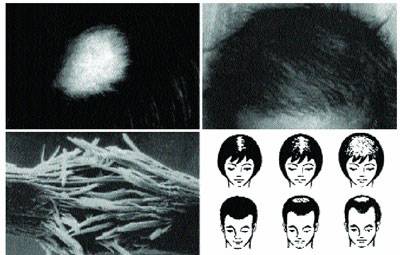 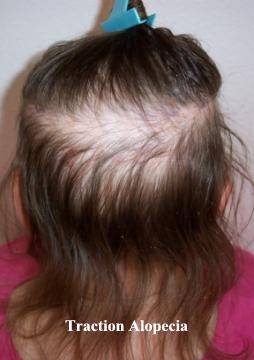
Traction Alopecia
His condition
is caused by localized trauma to the hair follicles from tight
hairstyles that pull at hair over time. If the condition is
detected early enough, the hair will regrow. Braiding, cornrows,
tight ponytails, and extensions are the most common styling
causes.
The following
hormonal contraceptives have a significant potential of causing
or exacerbating hair loss.
It is important to note that any medication or therapy that
alters a woman's hormones, including but not limited to,
contraceptives, can trigger hair loss in anyone who takes them.
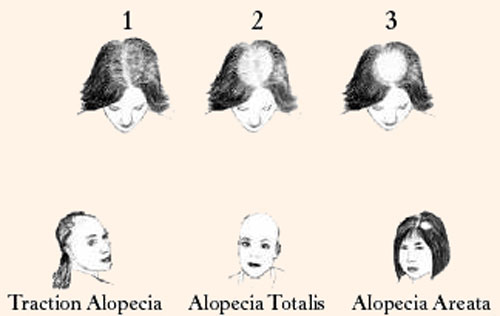
Progestin
Implants
Implants,
such as Norplant, are small rods implanted surgically beneath
the skin, usually on the upper arm. The rods release a
continuous dose of progestin to prevent ovulation. 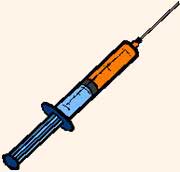
Hormone
Injections
Progestin
injections, such as Depo-Provera, are given into the muscles of
the upper arm or buttocks. This injection prevents ovulation.
Skin Patch 
The skin
patch (Ortho Evra) is placed on your shoulder, buttocks, or
other location. It continually releases progestin and estrogen.
Vaginal Ring
The vaginal
ring (NuvaRing) is a flexible ring about 2 inches in diameter
that is inserted into the vagina. It releases progestin and
estrogen.
To get rid of all your problems related to hair loss call now or
make an online appointment for a free consultation with a
professional consultant at Invision |







